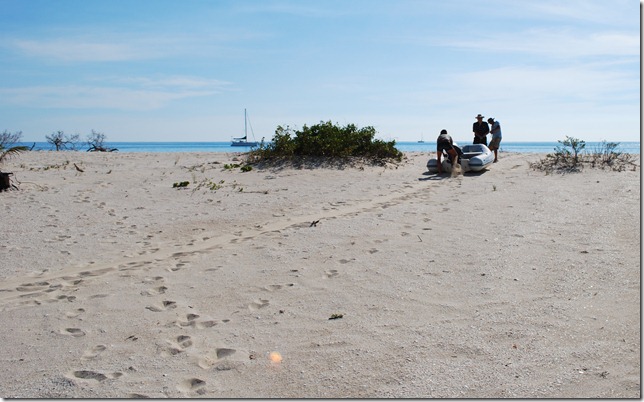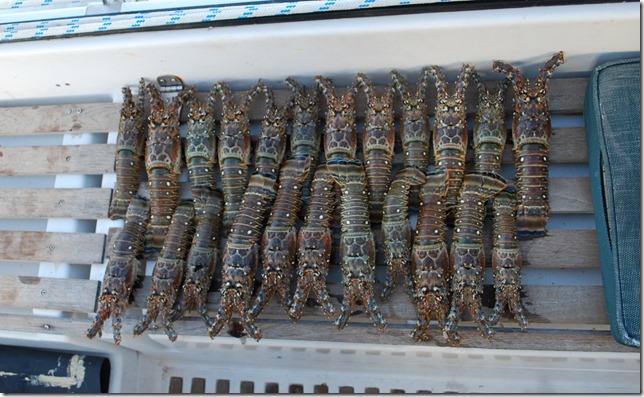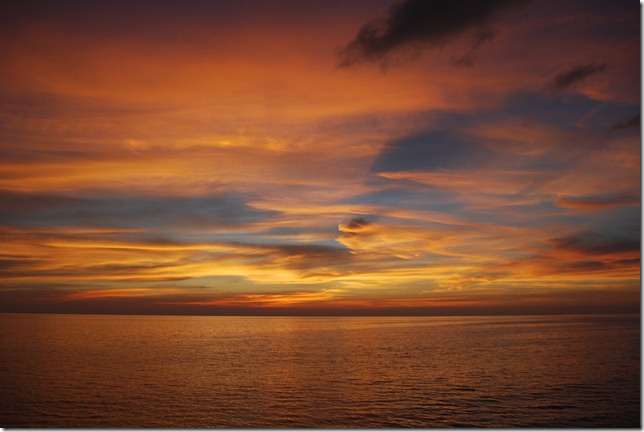Our pleasant stop in Antigua finally came to an end Thursday when Lauren and I weighed anchor early in the morning and headed for Barbuda. The sail from Antigua to Barbuda can be a pretty rough one, but the trades have been incredibly light (less than 10 knots) for the last week or so, leaving us to motor the 50 miles from English Harbour to Barbuda’s Low Bay.
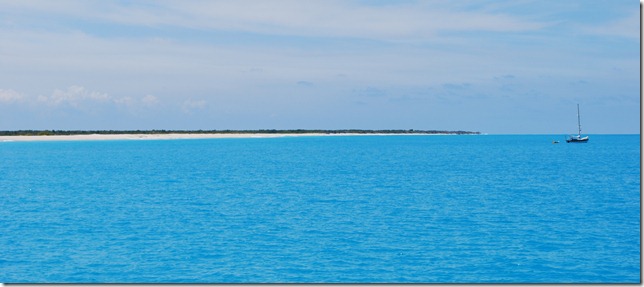 Barbuda is a postcard – gorgeous water, uncrowded anchorages, and empty beaches to the horizon
Barbuda is a postcard – gorgeous water, uncrowded anchorages, and empty beaches to the horizon
Barbuda is somewhat unique for the Caribbean. It’s a low island that has miles and miles of beautiful beaches but now has only one major resort left on the island, and it’s only open during the high season. Because it’s less visited, it has been the home to some pretty exclusive resort and celebrity guests – Princess Diana made several visits, and one resort has its own airstrip so that guests can skip the hustle and bustle of Barbuda’s public airport, with its one daily flight from Antigua. The fringing reefs, which extend well offshore, have claimed over 200 ships over the years, nearly all in the days before GPS and accurate charts. These days Barbuda’s claims to fame are less glamorous – lobsters, a bird sanctuary, and an interesting land act. Barbuda was originally leased to a single wealthy family (the Codrington’s) who used it primarily as a supply and slave depot for their other land holdings in the Caribbean. The island’s 1500 inhabitants are almost entirely descendants from those early slaves. Private property never really took hold in Barbuda, and today the Barbuda land act officially makes all the land in Barbuda the common property of all of the inhabitants of Barbuda. The Barbuda council is free to make leases with commercial interests and grant Barbudans land for houses, farming, etc., but there isn’t a single real estate agent to be found. It’s definitely a unique system, but the slow pace of life and absence of large-scale tourism seems to be the way most Barbudans prefer things.
One other very unique feature of the island is its large saltwater lagoon with the island’s only town, Codrington, located on its eastern shore. We’d been told in Antigua that the ferry bringing Lauren’s parents would land on the beach in Low Bay, but once in Barbuda, we quickly learned that wasn’t the case. The ferry actually comes to the south side of the island. Our backup plan was to meet in Codrington, and the place is small enough that “meet us in town” is actually enough to get the job done. The 2-mile dinghy ride from Low Bay to Codrington isn’t the difficult part of getting there (although in strong trades it is the wet part). The difficult part is hauling the dinghy over the sand spit separating Low Bay from the inner lagoon. Our dinghy and engine together weigh over 225 pounds, and dragging them up and across the 100 ft or so of sand spit called for lots of rest breaks.
After picking our anchoring and spit-crossing spot poorly on Thursday night, we re-anchored Friday morning right next to the best spot for crossing and were pretty happy to be across the spit in less than ten minutes. We reached the boat dock in Codrington just before Robin and Rindy pulled up in a taxi from the south side of the island, and together we began our day of Barbuda exploring. First up was lunch. We initially tried the one restaurant we’d spotted the previous evening. The painted sign above the door only said “REST”, but the missing space for more letters, roasting meat in the window, and two tables inside filled got the rest of the message across. It was closed and a second two-table restaurant we found wasn’t ready to serve food yet, so we headed for a roadside “no-table” restaurant that we’d sampled the night before and found to be a four-star sort of joint (as long as you’re only rating the quality of the food and the friendly company).
The stand’s proprietor, Washington, had outdone himself with jerk chicken, conch stew, dukanah (a local sweet, spiced dumpling), pastry, cooked vegetable “chop-up”, plantains, and potatoes. Next to the tiny shop where picked up cold beers to accompany our lunch, we found some loose cinder blocks in an unfinished (barely started) building and sat down in the shade to catch a break from the heat and enjoy our meal. Reviews were two-thumbs up for the food, but seating and ambiance isn’t quite ready for the cruise ships yet.
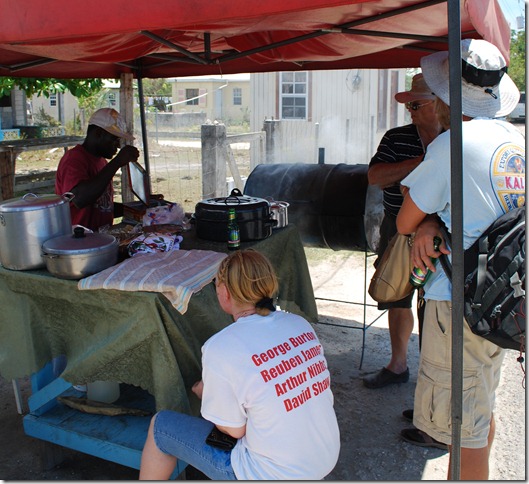 Barbuda’s local five-star dining
Barbuda’s local five-star dining
Good Friday is a holiday on Barbuda, and it took the better part of an hour and lots of help from locals to track down customs and immigration officers, get them to come to their closed offices, and get checked out. The customs guy in Codrington works out of a small room at the front of his house, has a hand-painted sign in the yard that says “customs”, and asked me for a job on board our “yacht”. He was a really friendly guy, but after I explained that our crew pays us instead of the other way around, he wasn’t too interested in a position.
Our next stop was the frigate bird sanctuary in the northern part of the lagoon. A local named Solomon took us on the short tour and we were impressed with large birds and how close they let us come in the boat. Frigate (or man-of-war) birds earned their name by harassing other birds in flight into surrendering their catch to supplement the fishing they do on their own. Although the frigate bird has the largest wingspan-to-weight (6-8 ft and only a few pounds) ratio of any bird, it can’t take off from the water, so it has to fly low and scoop small fish from the surface of the ocean instead of diving like a pelican. Barbuda has no natural predators and their nests in the mangroves are completely surrounded by water anyway, so the frigate birds seem to be pretty happy here. We even caught sight of several males, who are supposed to have migrated to other locations already.
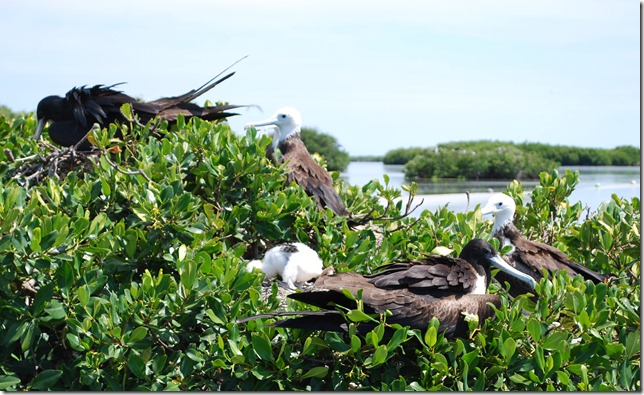 Male (all black top-left), female (white breast in foreground) juveniles (white heads), and chick (fluffy white in center) in the mangroves
Male (all black top-left), female (white breast in foreground) juveniles (white heads), and chick (fluffy white in center) in the mangroves
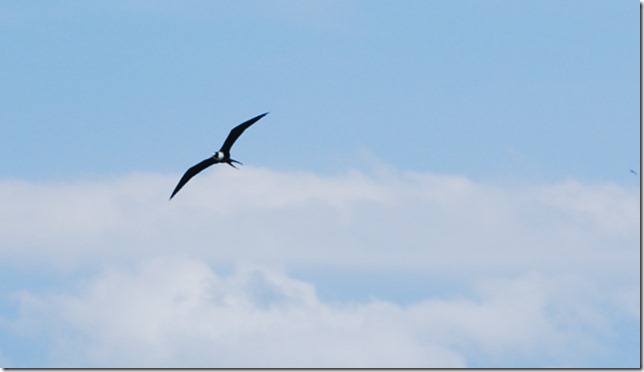 The frigate bird silhouette is distinctive
The frigate bird silhouette is distinctive
Barbuda is renowned for its plentiful spiny lobsters, but between the holiday and a local who buys up all the lobster daily to fly to Guadeloupe twice a week, I was having trouble finding any. The going rate is $5-6 USD/lb (live weight) so I was hoping to stock up. Solomon happened to have a 9 lb bag burlap bag of them hanging under the dock that he sold us before we left and as we motored back across the lagoon toward the spit, the driver of a local boat waved to us to stop. We’d heard “Goldilocks” was a fisherman that was a good bet for selling lobster, and it turned out to be him in the boat. He’s been lobstering in the lagoon and surrounding waters for 40 years and his day’s catch proved he’s pretty adept at it. Instead of traps, he uses a wire noose at the end of a metal rod. He slips the end of the noose around the lobster’s tail and when it moves, the noose tightens and into the bucket goes another lobster. It’s a technique we’d heard of before, but I never imagined it could be so effective.
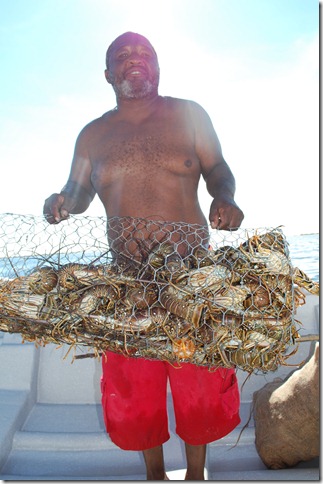 Goldilocks with about half his catch
Goldilocks with about half his catch
Back at the boat, we jumped into the turquoise water to cool down and then I started cleaning lobsters to store in the freezer. They weren’t large, but the final count was 23 of them for less than $60 USD. Not bad. After killing them and trimming a few extraneous parts they fit nicely into the freezer. Believe it or not, this was the first time on the trip Lauren had cooked lobster, and as usual she did an incredible job. Pan-fried with butter, garlic, and some fresh lime juice, they didn’t last long.
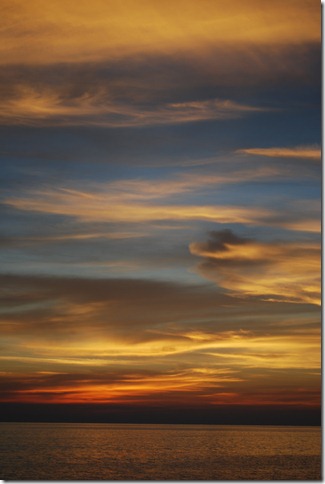 Robin’s sunset pictures made for some tough choices…
Robin’s sunset pictures made for some tough choices…
After dinner and a round of cards, we fired up an engine and started motoring toward St. Kitts. Sunrise found us just east of the Narrows between Nevis and St. Kitts and with the calm conditions, we were able to motor through the Narrows and up to Basse-Terre to clear in. A cruise ship had arrived just before us, and things were a bit of a circus during the check-in. It turns out that checking in the 3200 passengers and 1200 crew is no more difficult for them than checking us in, although our crew/passenger list is one page and theirs was thick enough to look like the white-pages. I’m pretty sure it will fall into the category of printed but never read.
After checking in, we moved over to South Frigate Bay for the night. I was pretty exhausted from the night sail and turned in early, but one of the clubs on the beach was having a 10th anniversary party that made getting to sleep a slow but melodious affair. A fireworks display overhead and a pretty talented band had things going strong well into the wee hours. As seems to be the case in many places here in the islands, the speakers were still pumping Caribbean dance music when the sun came up.


